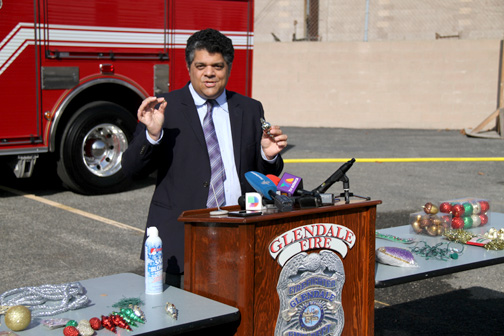
By Charly SHELTON
The winter holidays mean family gatherings, big dinners, hauling out the decorations and lighting up a decorative object, be it a Christmas tree, a menorah, a kinara, diyas or Yule log. And with these events come specific, holiday-themed poison dangers, especially for young children.
“We have lots of people coming over, we have lots of items in the home that we’re not used to bringing into the home. Supervision of our children may be a little bit less than what we’re accustomed to because of all the hustle and bustle and the busy times in our homes. That’s a time when you can have increased incidents of poisonings and exposures in the home that result in a health threat that requires hospitalization or perhaps even worse,” said Dr. Cyrus Rangan, medical toxicologist with California Poison Control System.
Dr. Rangan showed off some of the possibly poisonous items associated with the holidays that adults should watch out for, not only for their children but for all members of the family. Some of these may seem a bit odd, but Dr. Rangan assured that these all carry real perils if handled improperly.
The artificial snow used to decorate trees and windows, while itself is not toxic, can be harmful because of the fumes from the delivery system. The pressurized can releases fumes used to keep the contents under pressure and, until they dissipate, can cause an inhalation risk. If decorating windows with spray snow, apply it to the outside of windows, not the inside. And if applying flocking to a Christmas tree, let the professionals at the tree lot do it. It’s easier and safer.
Ornaments and small decorations can present a choking hazard either by themselves or when pieces break off. The ornaments can also break, presenting not only a choking hazard but a cut-and-scrape hazard. And the paint on some ornaments, especially older ones, can chip. Many of these have heavy metals, which present an ingestion hazard and heavy metal poisoning. So if there is a small piece of a broken ornament with shiny heavy metal paint, it becomes a triple threat to a curious child.
And the same thing goes for wrapping paper.
“Sometimes our specialty wrapping paper is another item that can contain pigments, so we advise that you don’t let your children chew on the wrapping paper because that could present a hazard as well,” Dr. Rangan said. “In addition, please don’t throw your wrapping paper into the fireplace. These wrapping papers are not designed to be thrown into the fireplace. The fumes that come off of the wrapping paper, because of the pigments that we use sometimes in those papers, can present an inhalation hazard as well.”
During the holidays, as throughout the year, candies and nuts can present a choking hazard and carefully watching children is key to making sure they’re out of reach. Similarly, cigar and cigarette butts should be kept away. While lit or smoldering, they are a fire hazard. But even when extinguished, a child could get it and eat it, causing nicotine poisoning.
In addition to the holidays, Dr. Rangan said, the chilly season poses its own challenges. Only use proper devices to heat the home. Using an oven or stove or a barbecue or fire pit from outside is dangerous not only due to the fire aspect but also because of the gasses thrown off.
Carbon monoxide is a silent gas – it has no smell and cannot be seen. It is only after symptoms begin to show it is apparent there is a problem. The symptoms are general and vague and vary from person to person. Symptoms can include headaches or wooziness, and lead up to seizures, fainting and heart attacks. Dr. Rangan advised that not only is a good smoke detector important, but a good carbon monoxide detector can help to identify any gas present.
So to recap – put fake snow on the outside of windows, keep ornaments out of reach of kids, open presents with hands, not teeth, don’t burn wrapping paper, don’t leave the ashtray out unattended and only use a real heater. But beyond all this, just watch over children. Almost all of the holiday time poisonings and hazards can be prevented through diligence and keeping an eye on kids too small to know better than to eat ornaments and wrapping paper.
For more information and safety tips, visit CalPoison.org.
